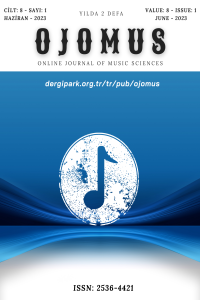GIOACHINO ROSSINI'NİN “L'ITALIANA IN ALGERI” OPERASINDAN "CRUDA SORTE" ARYASINDA ZAMANLAMAYA YÖNELİK PİYANO EŞLİK ANALİZİ
Bu çalışmada Rossini’nin “L'italiana in Algeri” (Cezayir'de Bir İtalyan Kızı) operasının “Cruda Sorte” adlı aryasının piyano eşliği açısından zamanlama konuları belirlenerek, belirlenen konulara çözüm önerileri getirilmiştir. Araştırmada içerik analizi yöntemi izlenmiştir. Bulgularda zamanlama uyumunu sağlamak için eşlikçiden beklenen dört farklı beceri görünmektedir. Eserde yapılan analiz sonucunda, 16’sı A türünde (eşlik partisindeki sus olmayan vuruşları solistin partisindeki sus olmayan vuruşlarla denk getirmek ve bunun için solist partisindeki hangi ritimleri takip edeceğini bilmek), 12’si B türünde (eşlik partisindeki sus olan vuruşlar ile vokal partideki ilgili vuruşları eşleştirerek, susun devamını eşleştirdiği eslerin devamı olacak şekilde seslendirmek ve bunun için solist partisindeki hangi ritimleri takip edeceğini bilmek), 5’i C türünde (gerekli yerlerde tempoyu esnetebilmek) ve 7’si D türünde (gerekli yerlerde belirlenmiş ya da istenen tempolara dönebilmek) beceriye ait olmak üzere 40 farklı noktada zamanlamaya yönelik öneriler getirilmiştir.
Anahtar Kelimeler:
Vokal müzik, piyano eşliği, zamanlama, Vokal müzik piyano eşliği, zamanlama
ANALYSIS OF THE PIANO ACCOMPANY FOR TIMING IN THE "CRUDA SORTE" ARY FROM GIOACHINO ROSSINI'S "L'ITALIANA IN ALGERI" OPERA
In this study, the timing issues of piano accompaniment in “Cruda Sorte” from “L’italiana in Algeri” by Rossini are identified and solutions to those issues are offered. The method of content analysis is utilized in the research. In findings, it is seen that four different skills are expected from the accompanist in order to ensure timing harmony. As a result of the analysis, made in the piece, 16 of them are in A type (to match the non-stop beats in the accompaniment part with the non-quiet beats in the soloist's part and to know which rhythms to follow in the soloist's part for this), 12 of them are in the B type (the silenced beats in the accompaniment part and the relevant ones in the vocal part). by matching the beats, to sing the rest of the silence as a continuation of the beats it matches and to know which rhythms the soloist will follow for this, 5 in C type (to be able to stretch the tempo where necessary), and 7 in D type (to be able to return to determined or desired tempos where necessary) Suggestions were made for timing at 40 different points, including the skill.
Keywords:
Vocal music, piano accompaniment, timing,
___
- Adler, K. (1965). Art of Accompanying and Coaching. University of Minnesota Press.
- Apel, W. (1974). Harvard dictionary of music (2nd ed.). The Belknap Press of Harvard University Press.
- Artaç, A. (2012). Operaların piyano eşliklerinin yorumlanması. Uludağ Üniversitesi Fen-Edebiyat Fakültesi Sosyal Bilimler Dergisi, 13 (23), 227-242. https://dergipark.org.tr/tr/download/article-file/272181
- Braaksma, J. (2020). Versatility at the piano: Developing the undergraduate collaborative pianist. [Yayımlanmamış doktora tezi]. Florida State University.
- Brittanica. (2007). Cavatina. 16 Ağustos 2021 tarihinde https://www.britannica.com/art/cavatina adresinden alınmıştır.
- Clarke, E. F. (1982). Timing in the performance of Erik Satie’s ‘Vexations’. Acta Psychologica, 50(1), 1-19. https://doi.org/10.1016/0001-6918(82)90047-6
- Gabrielsson, A. (1988). Timing in music performance and its relation to music experience. J. Sloboda (Ed.), Generative Processes in Music: The Psychology of Performance, Improvisation, and Composition (s. 27-51). Oxford University Press.
- Gabrielsson, A. (2003). Music performance research at the millennium. Psychology of Music, 31 (3), 221-272. https://doi.org/10.1177/03057356030313002 Kaptanoğlu, E., ve Çanakçı, P. (2015). Türkiye’de vokal müzikte piyano eşlik alanında yapılmış yüksek lisans, doktora ve sanatta yeterlik tezleri. Elektronik Sosyal Bilimler Dergisi, 14 (55), 198-206. https://doi.org/10.17755/esosder.20305
- Kokotsaki, D. (2007). Understanding the ensemble pianist: A theoretical framework. Psychology of Music, 35 (4), 641-668. https://doi.org/10.1177%2F0305735607077835 Lindo, A. H. (1916). The art of accompanying. G. Schirmer.
- Montgomery, A. (2020). Opera coaching: Professional techniques for the répétiteur (2nd ed.). Routledge.
- Okan, H. (2016). Müzik ve icra eğitiminde zamanlama becerilerinin yeri ve önemi. Uluslararası Eğitim Bilimleri Dergisi, (9), 104-120. https://dx.doi.org/10.16991/INESJOURNAL.1300
- Önal, D. (2010). Giuseppe Verdi’nin “La Traviata” operasının piyano eşlik problemleri (Yayın No. 286033) [Yüksek Lisans Tezi, Çukurova Üniversitesi]. Ulusal Tez Merkezi. https://tez.yok.gov.tr/UlusalTezMerkezi/TezGoster?key=zD1B0cW7zVr3VcnZjitVXklkwbwxJ1sGbjChJT7PpLR6u8yDbqkPSEDxmwNrN_Gi
- Özel, I. (2012). Bireysel ses eğitiminde piyano eşliğinin önemi (Yayın No. 319888) [Yüksek Lisans Tezi, Afyon Kocatepe Üniversitesi]. Ulusal Tez Merkezi. https://tez.yok.gov.tr/UlusalTezMerkezi/TezGoster?key=RYan9_S-Z7Eir3xdWGXBiFNz3WOBZ5UcjldTFg7MU2JxvO4gvGygsOcjWnUPoB1r
- Peñalver Vilar, J. M., & Valles Grau, L. (2020). Vocal piano accompaniment: A constant research towards emancipation (1). English Language, Literature & Culture, 5 (1), 13-24. https://doi.org/10.11648/j.ellc.20200501.12
- Phillips, A. (1999). Rossini’s reform: The controversy surrounding the use of embellishment. [Yayımlanmamış lisans tezi]. University of Tasmania.
- Povel, D.-J. (1977). Temporal structure of performed music. Acta Psychologica, 41 (4), 309-320. https://doi.org/10.1016/0001-6918(77)90024-5
- Repp, B. H. (1992). Diversity and commonality in music performance: An analysis of timing microstructure in Schumann’s ‘“Träumerei”’. The Journal of the Acoustical Society of America, 92 (5), 2546-2568. https://doi.org/10.1121/1.404425
- Roussou, E. (2013). An exploration of the pianist’s multiple roles within the duo chamber ensemble. Proceedings of the International Symposium on Performance Science 2013 (s. 511-516). International Symposium on Performance Science, Brussels, Belgium: Association Européenne des Conservatoires.
- Sever, D. (2003). Mozart Lied’lerde piyano eşliği (Yayın No. 140801) [Yüksek Lisans Tezi, İstanbul Üniversitesi]. Ulusal Tez Merkezi. https://tez.yok.gov.tr/UlusalTezMerkezi/TezGoster?key=Keh6sQzap4ZTp8dqWPlH1F36A9OnvbK6PMkL1-ef-byVZ5Ku5_hyAF8ugJYe0DEb
- Shaffer, L. H. (1984). Timing in Solo and Duet Piano Performances. The Quarterly Journal of Experimental Psychology Section A, 36 (4), 577-595. https://doi.org/10.1080/14640748408402180
- Smith, B. (2015). Don’t listen to me, I’m just your partner: ensemble issues in duo settings. [Yayımlanmamış doktora tezi]. Arizona State University.
- Türk Dil Kurumu (2022). Zamanlamak. 28 Nisan 2022 tarihinde https://sozluk.gov.tr/ adresinden alınmıştır. Yıldırım, A. ve Şimşek, H. (2011). Sosyal bilimlerde nitel araştırma Yöntemleri. Seçkin Yayıncılık.
- Yüksel, K. (2010). Piyano eşlikli şan performansında eşlikçinin algısal ve psikomotor becerileri, deneyimi ve piyanistik düzeyinin zamanlama uyumuyla ilişkisi (Yayın No. 279520) [Yüksek Lisans Tezi, Gazi Üniversitesi]. Ulusal Tez Merkezi. https://tez.yok.gov.tr/UlusalTezMerkezi/TezGoster?key=veR1mHu9yoWjwcVUjCEoPLeOhxgMoXQEw-0n0wxUp449Ow01GW7FdTwIusWLyDWw
- ISSN: 2536-4421
- Yayın Aralığı: Yılda 2 Sayı
- Başlangıç: 2016
- Yayıncı: Nilgün SAZAK
Sayıdaki Diğer Makaleler
MÜZİK ÖĞRETMENLİĞİ PROGRAMLARINDAKİ MÜZİK TEKNOLOJİSİ DERSLERİNE İLİŞKİN BİR İNCELEME
Beste ASMA İPEKÇİLER, Öznur ÖZTOSUN ÇAYDERE
2. DÜNYA SAVAŞI DÖNEMİNDE KLASİK MÜZİK VE MÜZİKSEL GELİŞMELER
Aşkın BAKBAK, Tuğçe KAYNAK AKÇAOĞLU
NOTA YAZISININ BİLGİSAYAR ORTAMINA AKTARIMI SÜRECİNDE İZLENECEK YÖNTEMLER (FİNALE ÖRNEĞİ)
